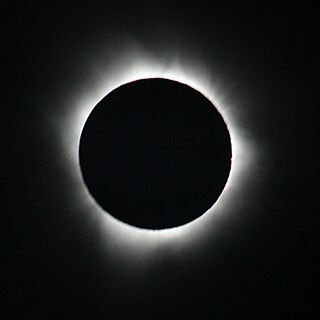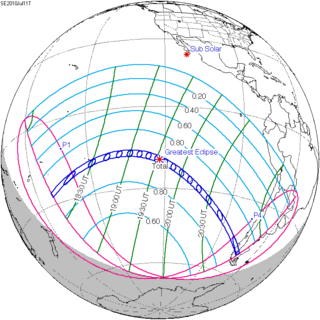| Solar eclipse of July 11, 2010 | |
|---|---|
 Totality from Hao, French Polynesia | |
| Type of eclipse | |
| Nature | Total |
| Gamma | −0.6788 |
| Magnitude | 1.058 |
| Maximum eclipse | |
| Duration | 320 s (5 min 20 s) |
| Coordinates | 19°42′S 121°54′W / 19.7°S 121.9°W |
| Max. width of band | 259 km (161 mi) |
| Times (UTC) | |
| (P1) Partial begin | 17:09:41 |
| (U1) Total begin | 18:15:15 |
| Greatest eclipse | 19:34:38 |
| (U4) Total end | 20:51:42 |
| (P4) Partial end | 21:57:16 |
| References | |
| Saros | 146 (27 of 76) |
| Catalog # (SE5000) | 9530 |
A total solar eclipse occurred at the Moon's descending node of orbit between Tuesday, July 11 and Wednesday, July 12, 2010,[1][2][3][4] with a magnitude of 1.058. A solar eclipse occurs when the Moon passes between Earth and the Sun, thereby totally or partly obscuring the image of the Sun for a viewer on Earth. A total solar eclipse occurs when the Moon's apparent diameter is larger than the Sun's, blocking all direct sunlight, turning day into darkness. Totality occurs in a narrow path across Earth's surface, with the partial solar eclipse visible over a surrounding region thousands of kilometres wide. Occurring about 1.6 days before perigee (on July 13, 2010, at 12:20 UTC), the Moon's apparent diameter was larger.[5]
- ^ "July 11, 2010 Total Solar Eclipse". timeanddate. Retrieved 11 August 2024.
- ^ "Total Solar Eclipse of 2010 July 11". NASA. Archived from the original on March 11, 2008. Retrieved July 12, 2010.
- ^ "Chasing a moment in the sun". The Ottawa Citizen. 2010-07-11. p. 12. Retrieved 2023-10-25 – via Newspapers.com.
- ^ "Solar eclipse fans chase moment (out of) sun". The Des Moines Register. 2010-07-11. p. 12. Retrieved 2023-10-25 – via Newspapers.com.
- ^ "Moon Distances for London, United Kingdom, England". timeanddate. Retrieved 11 August 2024.
